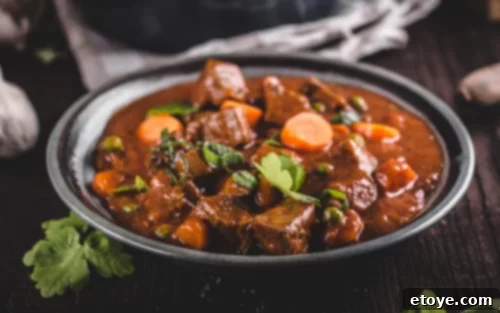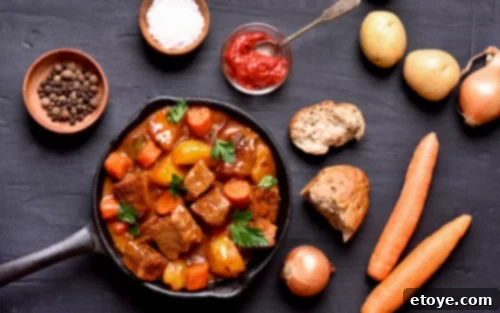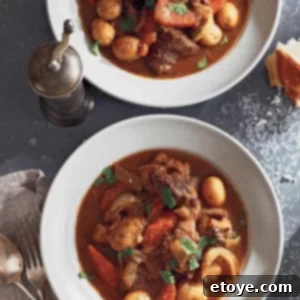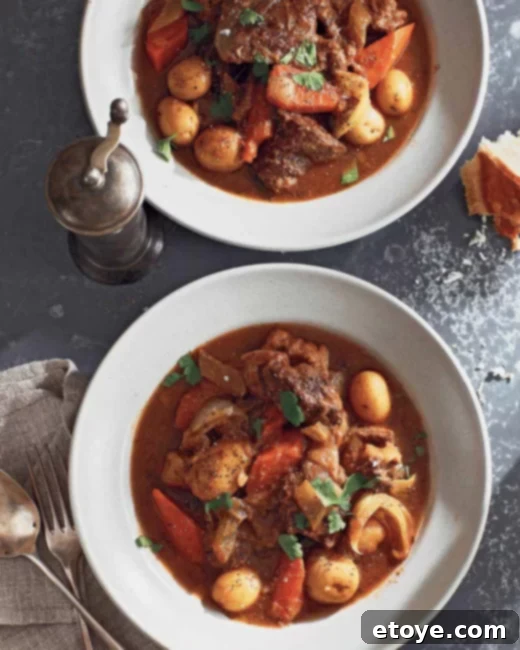Authentic Irish Guinness Beef Stew: The Ultimate Comfort Food Recipe
There are few dishes as soul-satisfying and deeply flavorful as a traditional Irish Guinness Beef Stew. This isn’t just any beef stew; it’s a genuine taste of Ireland, derived directly from the Official Guinness Cookbook. Having worked for Guinness over two decades ago, even spending time at their Scottish headquarters, I’ve had the privilege of experiencing the brand’s rich heritage firsthand. It brings me immense joy to share one of their most beloved and iconic recipes – a true testament to hearty Irish cooking.
Beef stew is a global culinary concept, evolving across cultures based on available ingredients and local traditions. The French enchant with their rich Beef Bourguignon, infused with Burgundy wine. Hungary offers the vibrant Goulash, characterized by its generous use of paprika. Belgium presents Carbonnade à la Flamande, a savory stew braised in Belgian ale. And then there’s Ireland, with its legendary Beef and Guinness Stew – a robust and wholesome dish designed to warm you from the inside out, no matter the weather. This stew is a staple of Irish pub lunches, a dish so fundamental that you can embark on a culinary journey across the country, discovering subtle variations in every establishment. Combining succulent meat, tender vegetables, earthy potatoes, and the unmistakable depth of Guinness, it truly embodies the definition of a complete meal in a single bowl.

Why This Guinness Beef Stew Recipe Achieves Culinary Excellence
This particular Guinness Beef Stew recipe is celebrated for its ability to deliver an exceptionally rich and complex flavor profile with every spoonful. Several key techniques and ingredient choices contribute to its remarkable success, elevating it from a simple stew to a truly memorable dining experience.
- The Essential Art of Searing for Unparalleled Flavor: The foundational step of searing the beef in batches is a crucial game-changer for this stew. This isn’t merely about browning the meat; it’s about initiating the Maillard reaction – a chemical process that caramelizes the natural sugars and amino acids on the surface of the beef. This reaction creates hundreds of new flavor compounds, adding a profound depth and savory richness that cannot be achieved by simply boiling the meat. The dark, crusty bits left at the bottom of the pan after searing, often called “fond,” are culinary gold. These concentrated nuggets of flavor are later deglazed and incorporated into the stew’s broth, infusing the entire dish with a rich, meaty essence that is the hallmark of a truly great beef stew. Taking the time for this step ensures an intensely flavorful foundation.
- The Dynamic Versatility of Liquid Choices: A standout feature of this recipe is its adaptability, allowing for both traditional alcoholic and non-alcoholic versions without compromising its inherent deliciousness. While the use of Guinness Draught Stout introduces a unique, malty, slightly bitter, and deeply complex flavor that is truly Irish, the recipe gracefully accommodates alternatives. For those seeking a different profile or avoiding alcohol, options like robust beef stock, a touch of strong brewed coffee, or even cola can provide surprising depth and color. This flexibility ensures that the stew can cater to diverse preferences, making it a beloved dish for a wider audience. Each liquid choice subtly shifts the character of the stew, inviting experimentation while always delivering comfort.
- A Symphony of Harmonized Flavors and Textures: The true beauty of this Guinness Beef Stew lies in its masterful ability to harmonize a diverse array of ingredients into a cohesive and delightful whole. Each element plays a vital role: succulent, fork-tender chunks of beef, earthy root vegetables, and hearty potatoes all simmer together in a rich, deeply flavored broth. The clever addition of brown sugar introduces a subtle sweetness that balances the bitterness of the Guinness. Tomato paste provides umami depth and a touch of acidity, while Dijon mustard adds a mild, tangy kick, elevating the overall complexity. Furthermore, the selection of vegetables contributes not only to the robust flavor but also to the varied textures, from the tender carrots and celery to the starchy potatoes. Optional additions like barley can further enhance the nutritional value and create an even thicker, more satisfying consistency, transforming this stew into a truly celebratory meal.

Achieving Perfection: Essential Tips for Your Guinness Beef Stew
To truly elevate your Guinness Beef Stew and unlock its full potential, consider these expert tips that build on the core principles of flavor development and ingredient selection. Following these guidelines will ensure a stew that is rich, tender, and deeply satisfying.
- Mastering the Art of Searing the Beef: This step cannot be overstated. Dedicate sufficient time to sear the beef in small batches, ensuring a beautiful, deep brown crust on all sides. Overcrowding the pan will steam the meat instead of searing it, preventing the development of those rich, caramelized flavors that are essential to the stew’s depth. The browned bits and fond left in the pan are packed with savory complexity and will infuse the vegetables and broth with an extraordinary richness when deglazed.
- Exploring Non-Alcoholic Alternatives: While Guinness is iconic, a delicious stew can absolutely be made without it. For a non-alcoholic version, excellent substitutes include robust beef stock, rich chicken stock, or even vegetable stock for a lighter base. For a unique twist, consider a combination of strong brewed coffee and a dark soda like root beer or cola – these surprisingly mimic the malty depth and subtle sweetness of stout without the alcohol. Apple cider can also add a pleasant tang and sweetness. Experimenting with these options allows you to tailor the stew to your preference or dietary needs.
- Finding the Perfect Guinness Substitute (If Needed): While Guinness Draught Stout is highly recommended for its classic flavor profile, if it’s unavailable, don’t despair. Any dark ale, stout, or porter will serve as a suitable substitute. Look for brews with similar characteristics: a rich, malty flavor, perhaps with notes of chocolate or coffee, and a moderate bitterness that will mellow beautifully during the long cooking process. Avoid overly sweet or highly hopped varieties.
- Enhancing with Additional Vegetables: This stew is incredibly versatile and welcomes a variety of vegetables. Choose heartier options that can withstand long cooking times.
- Mushrooms: Add whole or halved mushrooms (cremini or button) for an earthy depth. Sauté them briefly with the onions and carrots, or add them later for a firmer texture.
- Hearty Leafy Greens: Greens like collard greens or mature kale can be added directly to the pot during the simmering phase for a nutritious boost and a pleasant bitterness. They will soften beautifully over time.
- Root Vegetables: Incorporate other root vegetables such as parsnips or sweet potatoes alongside the regular potatoes and carrots. They add extra sweetness and texture. Butternut squash is also a delightful addition.
- Kale Preparation: For a fresher, brighter taste and vibrant green color, separate kale leaves from their tough stems. Chop the stems and add them with the other root vegetables. Tear the leaves into bite-sized pieces and stir them into the pot during the last 15-20 minutes of cooking. This preserves their color and a slight bite.
- Integrating Wholesome Grains: For an even heartier and thicker stew, consider adding grains. Pearl barley is an ideal choice, offering a chewy texture and contributing to the stew’s richness as it releases starch. Simply add about 1 cup of pearl barley to the pot at the same time you add the potatoes. It will cook slowly alongside the other ingredients, absorbing the magnificent flavors of the broth.

Key Ingredients for an Authentic Guinness Beef Stew
The success of this traditional Beef and Guinness Stew lies in the quality and balance of its core ingredients. Each component plays a vital role in creating the rich, deep flavors that define this classic Irish dish.
- 2 tablespoons extra-virgin olive oil: While the original recipe suggests beef drippings for ultimate richness, olive oil provides a healthier yet equally effective medium for searing and sautéing.
- 2 pounds (900g) chuck roast: This cut of beef is ideal for slow-cooked stews due to its marbling and connective tissue, which break down over time to become incredibly tender and flavorful. Trim any large pieces of excess fat and cut into uniform 1.5-inch (3.8 cm) pieces for even cooking.
- 2 onions, sliced: Onions form the aromatic base of the stew, caramelizing to add natural sweetness and depth.
- 3 celery stalks, chopped: Celery contributes a fresh, savory note, part of the classic mirepoix that builds foundational flavor.
- 3 carrots, peeled and cut into 2-inch (5cm) chunks: Carrots add a touch of sweetness, vibrant color, and essential nutrients. Cutting them into larger chunks ensures they hold their shape during the long simmer.
- 2 tablespoons all-purpose flour: Flour acts as a thickening agent, creating a richer, more substantial gravy for the stew. It also helps to coat the meat, allowing for a better sear.
- 1 can Guinness Draught Stout (14.9 oz): The star ingredient! Guinness provides unparalleled malty sweetness, a subtle bitterness, and a deep, complex flavor that is truly unique to this Irish stew.
- 1 cup (240ml) beef stock: Beef stock augments the savory beef flavor, ensuring a robust and well-rounded broth.
- 1 tablespoon brown sugar: This ingredient is crucial for balancing the bitterness of the Guinness and the acidity of the tomato paste. The original recipe often calls for apple jelly or red currant jelly, which provide a similar sweet-tart balance. Brown sugar is a readily available and effective substitute.
- 2 tablespoons tomato paste: Tomato paste adds a concentrated umami flavor, a touch of acidity, and helps to deepen the color of the stew.
- 1 teaspoon Dijon mustard: Dijon mustard provides a subtle tang and a slight kick, enhancing the overall flavor complexity without being overpowering.
- 2 sprigs fresh thyme (or 1 tsp dried thyme): Thyme is a classic herb for beef stews, imparting an earthy, aromatic quality. Fresh sprigs can be easily removed before serving.
- 2 bay leaves: Bay leaves release a subtle, woodsy aroma that complements the rich flavors of the stew during cooking. Remember to remove them before serving.
- Sea salt and freshly ground black pepper: Essential seasonings to enhance all the flavors and ensure the stew is perfectly balanced. Season generously but adjust to taste throughout the cooking process.
- 8 ounces (225g) baby or red potatoes, scrubbed: Potatoes are the hearty element, absorbing the delicious stew liquid and providing a satisfying texture. If using larger potatoes, cut them into substantial 1.5-inch (3.8 cm) chunks so they don’t disintegrate during cooking.

Step-by-Step: Crafting Your Guinness Beef Stew
Follow these detailed instructions to create a rich and tender Guinness Beef Stew that will impress your family and friends. This recipe emphasizes careful technique to build layers of flavor.
- Prepare the Beef: In a heavy-bottomed, ovenproof casserole dish or Dutch oven with a lid, heat the extra-virgin olive oil over medium-high heat. Once shimmering, add the beef chuck roast pieces in batches. Do not overcrowd the pan; searing in batches ensures a deep, rich brown crust on each piece, which is crucial for flavor development. Sear each side until beautifully browned, then transfer each seared batch to a plate and set aside.
- Sauté the Aromatics: If the pan appears dry after searing the beef, add a small amount of additional olive oil if needed. Then, add the sliced onions, chopped celery, and carrot chunks to the pan. Cook these vegetables for about 5 to 7 minutes, stirring occasionally, until they begin to soften and become slightly translucent, picking up some of the flavorful fond from the bottom of the pot.
- Thicken with Flour: Sprinkle the all-purpose flour over the softened vegetables. Cook, stirring constantly, for 2 to 3 minutes. This step, known as creating a roux, allows the flour to cook out its raw taste and will help to thicken the stew’s gravy later.
- Deglaze and Build the Broth: Pour in the Guinness Draught Stout, beef stock, brown sugar (or jelly), tomato paste, and Dijon mustard. Bring the mixture to a boil, stirring continuously and scraping the bottom of the pan with a wooden spoon or spatula. This action deglazes the pan, dissolving all those delicious browned bits (fond) and incorporating them into the liquid, adding immense depth of flavor to your broth.
- Simmer the Stew Base: Return the seared beef to the pan, along with the fresh thyme sprigs and bay leaves. Season generously with sea salt and freshly ground black pepper. Stir everything together, then cover the dish with its lid. Reduce the heat to low and allow the stew to simmer very gently on the stovetop for 2 hours. This slow cooking allows the beef to tenderize and the flavors to meld beautifully.
- Add Potatoes and Finish Cooking: After the initial 2 hours of simmering, add the scrubbed baby or large chunks of red potatoes to the pot. Ensure they are submerged in the liquid. Continue to simmer the stew, covered, for an additional 1 hour, or until both the potatoes and the beef are perfectly tender and can be easily pierced with a fork.
- Final Seasoning and Serving: Taste the stew and adjust the seasoning with additional salt and black pepper as needed. Before serving, carefully remove and discard the bay leaves and thyme stems. Ladle the hot, hearty Guinness Beef Stew into bowls and serve immediately with your favorite accompaniments.
Chef’s Note: This versatile stew can also be cooked in the oven for hands-off simmering. After completing step 4, transfer the covered casserole dish to a preheated oven at 325°F (160°C). Bake for 2 hours. Then, add the potatoes (as per step 5) and continue to bake for 1 hour more, until everything is wonderfully tender.

Frequently Asked Questions About Guinness Beef Stew
Here are answers to some common questions about preparing and enjoying this delightful Irish Guinness Beef Stew:
Can I use Guinness Extra Stout instead of Guinness Draught Stout in this recipe?
Absolutely! While the original recipe traditionally calls for Guinness Draught Stout, using Guinness Extra Stout is an excellent choice for those who appreciate a more pronounced, deeper, and slightly more intense roasted flavor in their stew. Both varieties of Guinness beer will contribute that signature rich, malty, and slightly bitter taste, making your beef stew unmistakably Irish and wonderfully complex.
What are the best side dishes to serve with this hearty stew?
For the quintessential comfort meal, nothing beats serving this Guinness Beef Stew with a warm, crusty loaf of traditional Irish soda bread. The dense texture and mild flavor of the soda bread are perfect for soaking up every last drop of the delicious, rich sauce. On a particularly cold night, a side of creamy mashed potatoes (like colcannon or champ) or simple crusty French bread would also be a perfect accompaniment, adding another layer of comforting warmth and texture.
How long can I store leftovers, and can this stew be frozen?
Leftover Guinness Beef Stew can be stored safely in an airtight container in the refrigerator for up to 3 to 5 days, making it an excellent meal prep option. Furthermore, this stew freezes beautifully! Allow the stew to cool completely to room temperature before transferring it into freezer-safe containers or heavy-duty freezer bags. It can be stored in the freezer for up to 3 months. To reheat, simply thaw overnight in the refrigerator, then gently warm it on the stovetop over low heat, stirring occasionally, until heated through.
Can I add other vegetables or ingredients to enhance this stew?
Absolutely! Feel free to personalize your stew and boost its nutritional value or flavor profile. You can add small pearl onions for a sweeter, more refined touch, or stir in frozen peas during the last 10 minutes of cooking for a pop of color and freshness. Chunks of parsnip, turnip, or even sweet potato can be added alongside the other root vegetables for additional earthy flavors and varying textures. Fresh herbs like rosemary or parsley also make excellent additions. Be creative, but consider the cooking times of any new vegetables to ensure they don’t become overcooked or undercooked.
What specific role does Guinness play in the flavor of this stew?
Guinness beer is often referred to as the “secret ingredient” in this stew, and for good reason! It imparts a unique depth of flavor that is genuinely difficult to replicate with other liquids. Its characteristic malty sweetness, subtle roasted notes, and underlying bitterness mellow wonderfully during the long simmering process. This creates a rich, complex, and slightly earthy base that perfectly complements the savory tender beef and vegetables, adding an authentic Irish character to the dish.
Do I need to trim the excess fat from the beef chuck before cooking?
For the best flavor and texture in your finished stew, it is generally a good idea to trim off any large, excessive pieces of exterior fat from the boneless beef chuck roast before you cut it into 1.5-inch cubes. A small amount of marbling (internal fat) is desirable as it adds moisture and flavor, but large chunks of external fat can make the stew overly greasy. Trimming ensures your beef stew meat remains lean enough for a hearty, satisfying meal without an unpleasant oily residue.


Official Guinness Beef Stew Recipe
Adapted from The Official Guinness Cookbook. A hearty and wholesome dish that will keep you warm and comfortable no matter what the weather throws at you. With meat, veggies, potatoes and Guinness, this is the very definition of a meal in a bowl.
Prep Time: 10 mins
Cook Time: 3 hrs 30 mins
Total Time: 3 hrs 40 mins
Course: Dinner, Lunch
Cuisine: Irish
Servings: 4 people
Calories: 406 kcal
Pin Recipe
Ingredients
- 2 tbsp extra-virgin olive oil (or beef drippings)
- 2 pounds (900g) chuck roast, fat trimmed and cut into 1.5-inch pieces
- 2 onions, sliced
- 3 celery stalks, chopped
- 3 carrots, peeled and cut into 2-inch chunks
- 2 tbsp all-purpose flour
- 1 can Guinness Draught Stout (14.9-fluid-ounce)
- 1 cup (240ml) beef stock
- 1 tbsp brown sugar (or apple jelly/red currant jelly)
- 2 tbsp tomato paste
- 1 tsp Dijon mustard
- 2 sprigs fresh thyme (or 1 tsp dried thyme)
- 2 bay leaves
- Sea salt
- Freshly ground black pepper
- 8 oz (225g) baby or red potatoes, scrubbed (if large, cut into 1.5-inch chunks)
Instructions
- In a heavy-bottom lidded ovenproof casserole dish or Dutch oven over medium-high heat, heat the olive oil. Add the meat in batches and sear each side until lightly browned, scooping each batch onto a plate as it is done.
- If the pan is too dry, add a little more oil as needed, then add the onions, celery, and carrots. Cook for 5 minutes, until the vegetables are starting to soften.
- Sprinkle with the flour and cook, stirring often, for 2 to 3 minutes.
- Add the beer, stock, brown sugar, tomato paste, and mustard, and bring to a boil, stirring and scraping to dissolve all the browned bits on the bottom of the pan.
- Return the meat to the pan, along with the thyme and bay leaves. Season with salt and black pepper, and cover with the lid. Turn the heat to low and simmer very gently for 2 hours.
- Add the potatoes and continue to simmer for 1 hour more, until the potatoes and meat are tender.
- Season with salt and black pepper, remove and discard the bay leaves and thyme stems, and serve.
Nutrition Information (per serving, approximately)
- Serving: 400g
- Calories: 406 kcal
- Carbohydrates: 23g
- Protein: 44g
- Fat: 15g
- Saturated Fat: 4g
- Polyunsaturated Fat: 1g
- Monounsaturated Fat: 8g
- Cholesterol: 112mg
- Sodium: 291mg
- Potassium: 1159mg
- Fiber: 3g
- Sugar: 7g
- Vitamin A: 6243 IU
- Vitamin C: 17mg
- Calcium: 73mg
- Iron: 5mg
Keyword: beef stew, guinness, stew
Tried this recipe?
Let us know how it was!
The Ultimate Comfort: Enjoying Your Homemade Guinness Beef Stew
There’s a unique satisfaction that comes from creating a dish steeped in tradition, especially one as comforting and flavorful as this Guinness Beef Stew. From the moment the rich aroma fills your kitchen to the first spoonful of tender beef and vegetables, you’ll understand why this recipe has endured for generations.
This isn’t just a meal; it’s an experience – a hearty embrace in a bowl, perfect for sharing with loved ones or savoring on a quiet evening. We’ve explored the history, the culinary science, and the essential tips to ensure your stew is nothing short of perfection. Each carefully selected ingredient and deliberate cooking step contributes to the magnificent depth and succulence of this authentic Irish classic.
Now that you have all the tools and knowledge, it’s time to gather your ingredients and embark on your own culinary journey. We encourage you to try this official Guinness Beef Stew recipe, make it your own with thoughtful additions, and discover the true joy of this ultimate comfort food. We’d love to hear about your experience! Share your thoughts and tell us how your stew turned out in the comments below.
